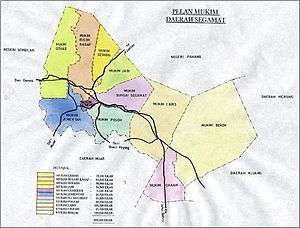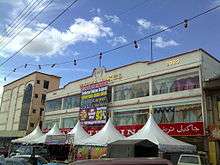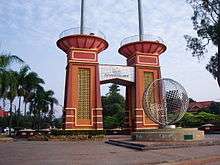Segamat District
| Segamat District சிகாமட் 昔加末 | ||
|---|---|---|
| District of Malaysia | ||
| ||
| Country |
| |
| State |
| |
| Seat | Segamat | |
| Government | ||
| • District officer | Haji Mohd Haffiz bin Haji Ahmad | |
| Area | ||
| • Total | 2,825.4 km2 (1,090.9 sq mi) | |
| Population (2010) | ||
| • Total | 182,985 | |
| • Density | 65/km2 (170/sq mi) | |
| Postcode | 85xxx | |
| Telephone area code | +60-07 | |
| Vehicle registration | J | |
The Segamat District is a district located in the north of the state of Johor in Malaysia, bordering Negeri Sembilan on the west and Pahang on the north. It is located roughly 172 kilometres from Johor Bahru, the capital city of Johor State. It is 95 km travel distance via North-South Expressway from Johor Bahru to Yong Peng, and another 77 km from Federal Route 1.

Strategically situated between Kuala Lumpur and Johor Bahru, Segamat is a fast-growing agricultural oil palm and rubber district, famous for its delicious durians, hence its recent slogan to attract tourists: Selamat Datang ke Segamat - Tanah Raja Buah-buahan (Malay: Welcome to Segamat - The Land of the King of Fruits). The eponymous town is a typical medium size town with a blend of old and new cultures. A mere 45 minute drive from town offers a variety of hiking and swimming sites namely the famous Gunung Ledang, Air Panas Waterfall and Bekok Waterfall which make an enjoyable weekend getaway.
History
According to local historian, Hassan bin Muhammad, the area used to be known as Rantau Panjang. In around 1511, a Bendahara of Malacca, Bendahara Tepok and his troops were retreating to Johor after the fall of Melaka to the invading Portuguese forces led by Afonso de Albuquerque. The Bendahara and his troops stopped and rested by a river in the area and drank water from the river. After the drink, the Bendahara exclaimed, "Segar amat!" (Malay: "Very refreshing!"), and named the river Segar Amat, in which over time evolved into Segamat. The name Segamat was initially applied only to the river, whereas the settlement nearby was still called Rantau Panjang. The town assumed the river's name only at the turn of the 20th century.
By the end of the 19th century, the four original districts have several minor subdistricts, for example the previous Muar District has 4 minor districts - Parit Jawa, Chohong, Lenga and Segamat. The first District Officer of Segamat Minor District was Encik Menthol bin Haji Ahmad. In 1933, the district of Segamat was formed after a major district boundary realignment was made by the government of Johor to split the original 4 districts (Muar, Batu Pahat, Johor Bahru and Sedili) into 8 districts (before the 2008 realignment which added the Kulai and Tangkak districts to form 10 districts in Johor).
After the formation of Segamat District, the government began to develop Segamat, mainly with agricultural activities to boost the economy of Segamat. This included the construction of the national railroad system passing the town of Segamat and also the construction of the main road known today as Federal Route 1.
In the 1970s, Tun Razak Highway was constructed to boost the economy of Segamat as an agricultural hub, to shorten the travelling time to Kuantan and to speed up the development progress of the poorly developed areas in southern Pahang.
The Johor branch campus of Universiti Teknologi MARA was constructed at Jementah in the end of the 1980s and started its operation in 1991. The construction of UiTM campus in Segamat district turned Segamat into another important educational hub in Johor besides Skudai, which houses Universiti Teknologi Malaysia.
In 1996, the Segamat Land Port was constructed to make Segamat an important transportational hub, like Nilai in Negeri Sembilan. By constructing the land port, manufacturers may just transport their goods to Segamat Land Port and then the goods can be transported to the nearest sea ports such as Pasir Gudang by train and this will increase the transportation efficiency. However, the plan did not materialise as planned; the space is subsequently rendered largely vacant as of latest 3 February 2012.
In 1999, the second bridge of Segamat, funded mainly by private developers, was constructed to reduce congestion at the main bridge. The second bridge was included as a part of Segamat Inner Ring Road package consisting the road upgrade to 4-lane road at Jalan Pemuda, Jalan Hassan, Jalan Pee Kang Hai and Jalan Chia Chin Koon, which was completed in August 2005. The inner ring road package is useful to divert the traffic flow when the main roads at the town center are closed for special occasions and events such as National Day.
Segamat experienced floods during the 1950s, 1984 and recently on 18 December 2006. The one in 2006, which was caused by Typhoon Utor in the Philippines, was generally considered to be the worst flood to have happened in Segamat and Johor. There is a conspiracy theory that the 2006 flood was caused by improper release of water from the upstream Bekok Dam. The theory is based on the fact that the water level of the Segamat River overflowed at a rate which was believed impossible to have been caused by rain alone.
Most recently, in January 2011, severe flooding occurred in Segamat and other parts of upstate Johor and the neighbouring state of Melaka, with about 31,000 people evacuated and several deaths.[1]
Segamat District Facts
Area:
- 2,825.4 km²
Population:
- 178,000 (1991 census)
- 270,000 (2010 projected)
Townscape
The town of Segamat is the fifth largest town in the state of Johor with about 80,000 residents. According to local residents of Segamat, the town center of Segamat can be divided into two, where both neighbourhoods are separated by Segamat River:-
- Bandar Atas (Uptown) - The original town center of Segamat. The official site of Segamat town center today is Dataran Segamat, or Segamat Square.
- Bandar Seberang (Crosstown) - Located at the other side across Segamat river. This neighbourhood is known as Bandar Seberang because of its location across Segamat river. This area houses most of the supermarkets and shopping centres in Segamat.
In addition to the town center, the urban area of Segamat also covers some villages and towns namely Pekan Jabi, Bukit Siput, Segamat Baru and Bandar Putra Segamat, which makes up the overall population of Segamat urban area to 100,000 residents.
The cost of living in Segamat is relatively affordable. Accommodation is readily available at the housing areas in Segamat town. Shophouses, supermarkets, restaurants and hawker centres in the proximity offer various and inexpensive choices for shopping, chilling out and eating out. A popular shopping market in Malaysia, Giant has also been constructed here.
Administrative divisions

Segamat is divided into 11 subdistricts or mukims. Each mukim is administered by a headman or penghulu.[2]
- Sungai Segamat - houses about three-quarter of Segamat town.
- Gemereh - The smallest mukim in Segamat
- Bekok - the largest mukim in Segamat
- Jabi
- Sermin
- Buloh Kasap
- Jementah
- Pogoh
- Labis
- Chaah
- Gemas
Mukim Sungai Segamat is the most populous residence in Segamat District since it houses the majority of Segamat town. The highest population density is in Mukim Gemereh, followed by Mukim Sungai Segamat with over 200+ residents per square km. The lowest population density is in Mukim Bekok with about 50 residents per square km.
The Segamat district is divided by two municipal administratives namely Majlis Daerah Segamat or Segamat District Council based at the town of Segamat and Majlis Daerah Labis or Labis District Council seated at the town of Labis.
Economy
Agriculture is the main contributor of Segamat's economy, contributing about 61.8% of the total employment in 1991. The second economic contributor is manufacturing sector, with 13.1% of total work force in 1995. This is followed by the government service sector, with 12.2% of total work force in the same year.
Commercial areas
The only shopping complex was built and started opening since year 2012 in Segamat named OneSegamat Mall, which is located adjoining the bus & taxi terminal and adjacent to the railway station, thus enjoying great traffic flow of shoppers and commuters creating excellent business potentials and sales prospects. The complex has the only cinema in Segamat located in its first floor, an 8-screen cinema operated by Lotus Five Star with a capacity around 1,800 people.
In the same year, a popular shopping KIP MART was built at the Bandar Utama.

Transportation
Car
Segamat is well-linked by both federal and state road networks. Highway ![]() , the main north–south trunk road of Peninsular Malaysia, runs through the town centre of Segamat.
, the main north–south trunk road of Peninsular Malaysia, runs through the town centre of Segamat.
The national expressway PLUS ![]() does not serve Segamat; motorists using PLUS are however able to get to Segamat by leaving the PLUS expressway at Exit 235 (Tangkak Interchange). From Exit 235, motorists can then use highway
does not serve Segamat; motorists using PLUS are however able to get to Segamat by leaving the PLUS expressway at Exit 235 (Tangkak Interchange). From Exit 235, motorists can then use highway ![]() and head north towards Segamat. Highway
and head north towards Segamat. Highway ![]() joins Segamat to Tangkak and terminates at Muar.
joins Segamat to Tangkak and terminates at Muar.
Meanwhile, motorists from the east coast especially Pahang, can access Segamat through Tun Razak Highway (highway ![]() ), which connects Segamat through Muadzam Shah to Gambang near Kuantan.
), which connects Segamat through Muadzam Shah to Gambang near Kuantan.
Besides, there are several main state roads in Segamat, namely:
- J14
 - Jalan Pogoh
- Jalan Pogoh - J32
 - Jalan Muar-Labis
- Jalan Muar-Labis - J43
 - Jalan Batu Enam
- Jalan Batu Enam - J150
 - Jalan Bekok
- Jalan Bekok - J153
 - Jalan Tasek Alai
- Jalan Tasek Alai
Public transportation
Rail
Segamat district is served by the state rail network KTM with Batu Anam, Bekok, Genuang, Labis, Segamat and Tenang Stations. Now the railway is connected from Segamat to Penang which located on the northwest coast of Peninsular Malaysia, this service given much convenience for who need to travel from southwest to northwest in Malaysia since there are few station to stop by in between the journey.
Road
There are three main intercity bus lines that serve the Segamat District:-
- Yow Hoe (Gemas-Ayer Hitam)
- North-West Johor (Segamat-Muar)
- Kenderaan Bas MARA-DARA (Segamat-Muadzam Shah) using highway

Major attractions
- Dataran Segamat - Dataran Segamat or Segamat Square was constructed in 1996 as the main venue for Johor's state level celebration of the Malaysian National Day. In 2005, when Segamat was once again chosen as the state-level host, Dataran Segamat was renovated beautifully. It also houses the clock tower and a durian replica that makes Dataran Segamat the landmark of Segamat. Location: 2°30'40"N ; 102°48'50"E.

- Taman Bunga Batu Hampar (Rock Garden) - The Rock Garden is the main recreational park in Segamat. It also houses the official residence of the District Officer of Segamat and also the Istana Hinggap, Johor royal retreat. Location: 2°30'59"N ; 102°48'43"E.
- Bendahara Tepok Tomb - The tomb of the final Bendahara of Sultanate of Malacca located at Kampung Lubok Batu, about 2 km from Segamat town center via Federal Route 23. Location: 2°30'03"N ; 102°48'30"E.
Education
Tertiary education
The district is home to two institutions: the Johore branch of the Universiti Teknologi Mara which is located about 8 kilometres or a 10-minute drive from the town; and the Johore campus of the Tunku Abdul Rahman University College where peoples called KTAR which began operating on 18 May 1998, located at an approximate 10-to-15 minutes driving distance south from the town. There is also a community college named Kolej Komuniti Segamat located at Bandar Putra IOI Segamat, a 7-kilometres drive from town,[3] that began its operations in June 2001.
Primary and secondary education
There are about 18 primary schools in the district. On the other hand, there are 19 secondary schools within the Segamat township. Some of those notable secondary schools include Sekolah Menengah Kebangsaan Agama Segamat, SMK Seri Kenangan Batu Anam, SMK Bekok, Sekolah Menengah Seg Hwa and Segamat High School.
Local legends
Segamat has a collection of local legends and folk stories, where some of them describe the name origins of several places in Segamat. However, many of the residents of Segamat have forgotten most of them, even among older generations.
Some of the legends concern the region's tendency to flooding, for example:
- A myth tells of a dragon, whose length spans the distance between Kampung Berata and Kampung Gemereh (~ 5 km). The dragon sleeps underground, and Segamat may experience very bad floods when the dragon changes its sleeping position, said to be caused by gaps made when the dragon moves. The dragon is called Ruby Dragon. This 'myth' is a modern-day myth and was not known or spoken of prior to the great flood of 2006. Old residents of Segamat never heard of Ruby Dragon, and it could just be a figment of someone's imagination. The story of a dragon sleeping under the river is a modern-day creation and has no history to it.
- Legend of Malim Deman: Malim Deman was a king in Segamat who was in love with Princess 'Santan Bertapis'. The princess was kidnapped by a spirit and Malim Deman swore that as long as the princess is not returned, the Segamat area shall experience floods for all eternity. However, with modern town planning and irrigation, flooding is now a rare occurrence in Segamat.
Other towns in Segamat District
- Bandar Putra (IOI)
- Labis
- Jementah
- Buloh Kasap
- Chaah
- Bekok
- Batu Anam
- Pogoh
- Pekan Air Panas
- Gemas Baharu
- Komplek penghulu mukim Bekok
- Sungai Karas
- Kampung Tengah
- Bandar utama
Notes
- ↑ "Segamat Cut Off", theSun, 1 February 2011
- ↑ http://apps.water.gov.my/jpskomuniti/dokumen/Segamat%20Profil%20(LATEST).pdf
- ↑ "Kolej Komuniti Segamat".
References
- YM Ungku Mohd. Zaman bin Tahir (1996). Segamat: Sejarah dan Mitosnya. Al-Kafilah Enterprise.
- Segamat District Council official website
External links
| Wikimedia Commons has media related to Segamat. |
| Wikivoyage has a travel guide for Segamat. |
- Segamat.com - community web sites of Segamat.
- Segamat.org - Chinese forum for Segamatians.
- Segamat Fotopages - Pics of Segamat from the webmaster of Segamat.fotopages.com
Coordinates: 2°30′N 102°49′E / 2.500°N 102.817°E
